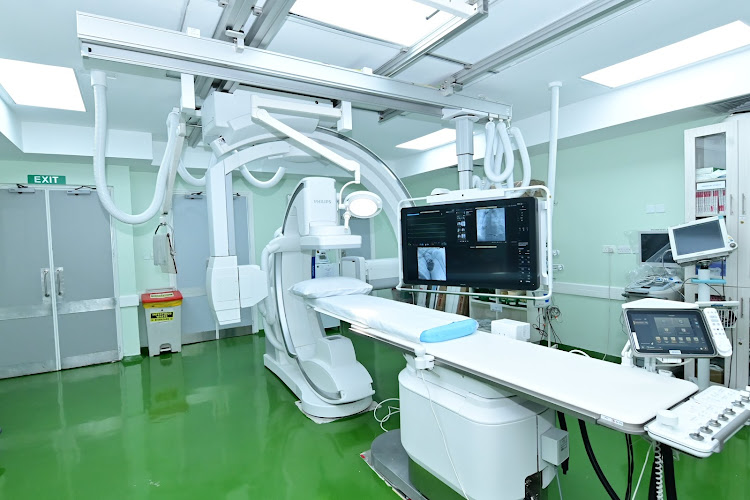
Cathlab Procedure
Our cathlab procedures are concluded at the Nairobi Hospital Catheterization facility
The catheterization laboratory, often called the “cath lab,” is a specialized medical facility equipped with advanced imaging and monitoring technology. It’s used for minimally invasive procedures involving catheters (thin, flexible tubes) to diagnose and treat cardiovascular conditions. Procedures in the cath lab include angiograms, angioplasties, stent placements, and more. It allows doctors to access blood vessels and the heart without major surgery, reducing risks and recovery time.
Overview
The catheterization laboratory, or cath lab, is a specialized medical facility where minimally invasive procedures are performed using catheters and advanced imaging equipment. It’s primarily used for diagnosing and treating cardiovascular conditions like blocked arteries, heart defects, and other related issues. Procedures conducted in the cath lab include angiograms, angioplasties, stent placements, and more. This approach reduces the need for extensive surgery, minimizes risks, and speeds up recovery times for patients.
The catheterization laboratory, often referred to as the cath lab, is a specialized medical facility within a hospital or medical center. It’s designed for performing minimally invasive procedures that involve the use of catheters, small hollow tubes, to diagnose and treat various cardiovascular conditions. The cath lab is a critical component of modern cardiology and provides a controlled environment equipped with advanced imaging and monitoring technology.
Functions and Procedures:
1. Angiography: One of the primary functions of the cath lab is to perform angiography, which involves injecting a contrast dye into blood vessels to visualize the blood flow and identify blockages, narrowings, or other abnormalities. This procedure helps diagnose conditions like coronary artery disease.
2. Angioplasty: During angioplasty, a catheter with a deflated balloon is threaded through blood vessels to the affected area. The balloon is then inflated to widen narrowed or blocked arteries, improving blood flow. This is often combined with stent placement.
3. Stent Placement: Stents are small mesh tubes inserted into narrowed arteries to keep them open. This helps maintain proper blood flow and prevent re-narrowing of the vessel.
4. Electrophysiology Studies (EPS): In cases of arrhythmias (abnormal heart rhythms), catheters are used to map the heart’s electrical pathways and identify problematic areas. This can guide the treatment of conditions like atrial fibrillation.
5. Biopsies and Interventions: Catheters can also be used to collect tissue samples (biopsies) from the heart, and interventions such as closing certain congenital defects or treating valve issues.
Equipment and Technology:
Cath labs are equipped with specialized imaging tools, such as fluoroscopy and digital subtraction angiography (DSA), which provide real-time X-ray images of blood vessels and the heart. These images help guide the placement of catheters and the performance of procedures. Additionally, advanced monitoring equipment tracks the patient’s vital signs and heart activity throughout the procedure.
Benefits:
– Minimally Invasive: Cath lab procedures are less invasive than traditional surgery, which leads to shorter recovery times and reduced risks.
– Precise Diagnostics: Cath lab procedures allow for accurate diagnosis and detailed visualization of cardiovascular conditions.
– Quick Intervention: Urgent cases, like heart attacks, can be treated rapidly in the cath lab to restore blood flow and minimize heart muscle damage.
Overall, the cath lab plays a pivotal role in diagnosing and treating various heart conditions, offering patients effective and less invasive options for managing cardiovascular health.
Emergency Cases
Please feel welcome to contact our friendly reception staff with any general or medical enquiry.